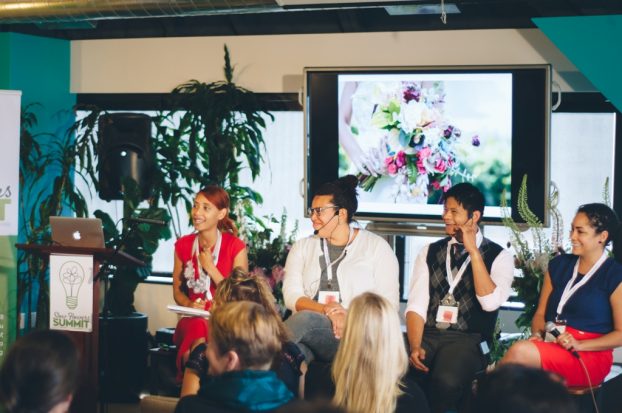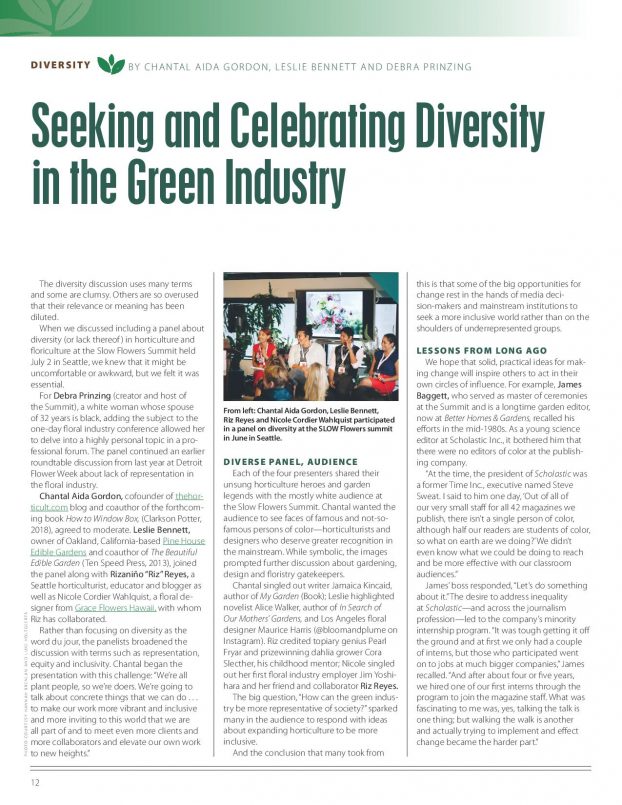Seeking and Celebrating Diversity in the Green Industry

Panelists, from left: Chantal Aida Gordon, Leslie Bennett, Riz Reyes and Nicole Cordier Wahlquist participated in a panel on diversity at the SLOW Flowers Summit in July in Seattle. (c) Hannah Brenlan and Luke Holtgeerts photography
This article is authored by Chantal Aida Gordon, Leslie Bennett and Debra Prinzing. It originally appeared in the September-October 2017 issue of On the QT, the newsletter of GWA: The Association for Garden Communicators
 The diversity discussion uses many terms and some are clumsy. Others are so overused that their relevance or meaning has been diluted. When we discussed including a panel about diversity (or lack thereof ) in horticulture and floriculture at the Slow Flowers Summit held July 2 in Seattle, we knew that it might be uncomfortable or awkward, but we felt it was essential.
The diversity discussion uses many terms and some are clumsy. Others are so overused that their relevance or meaning has been diluted. When we discussed including a panel about diversity (or lack thereof ) in horticulture and floriculture at the Slow Flowers Summit held July 2 in Seattle, we knew that it might be uncomfortable or awkward, but we felt it was essential.
For Debra Prinzing (creator and host of the Summit), a white woman whose spouse of 32 years is black, adding the subject to the one-day floral industry conference allowed her to delve into a highly personal topic in a professional forum. The panel continued an earlier roundtable discussion from last year at Detroit Flower Week about lack of representation in the floral industry.
Chantal Aida Gordon, cofounder of thehorticult.com blog and coauthor of the forthcoming book How to Window Box, (Clarkson Potter, 2018), agreed to moderate. Leslie Bennett, owner of Oakland, California-based Pine House
Edible Gardens and coauthor of The Beautiful Edible Garden (Ten Speed Press, 2013), joined the panel along with Rizaniño “Riz” Reyes, a Seattle horticulturist, educator and blogger as well as Nicole Cordier Wahlquist, a floral designer from Grace Flowers Hawaii, with whom Riz has collaborated.
Rather than focusing on diversity as the word du jour, the panelists broadened the discussion with terms such as representation, equity and inclusivity. Chantal began the presentation with this challenge: “We’re all plant people, so we’re doers. We’re going to talk about concrete things that we can do . . . to make our work more vibrant and inclusive and more inviting to this world that we are all part of and to meet even more clients and more collaborators and elevate our own work to new heights.”
DIVERSE PANEL, AUDIENCE
Each of the four presenters shared their unsung horticulture heroes and garden legends with the mostly white audience at the Slow Flowers Summit. Chantal wanted the audience to see faces of famous and not-so-famous persons of color—horticulturists and designers who deserve greater recognition in the mainstream. While symbolic, the images prompted further discussion about gardening, design and floristry gatekeepers.
Chantal singled out writer Jamaica Kincaid, author of My Garden (Book); Leslie highlighted novelist Alice Walker, author of In Search of Our Mothers’ Gardens, and Los Angeles floral designer Maurice Harris (@bloomandplume on Instagram). Riz credited topiary genius Pearl Fryar and prizewinning dahlia grower Cora Slecther, his childhood mentor; Nicole singled out her first floral industry employer Jim Yoshihara
and her friend and collaborator Riz Reyes.
The big question, “How can the green industry be more representative of society?” sparked many in the audience to respond with ideas
about expanding horticulture to be more inclusive. And the conclusion that many took from this is that some of the big opportunities for
change rest in the hands of media decision-makers and mainstream institutions to seek a more inclusive world rather than on the shoulders of underrepresented groups.
LESSONS FROM LONG AGO
We hope that solid, practical ideas for making change will inspire others to act in their own circles of influence. For example, James Baggett, who served as master of ceremonies at the Summit and is a longtime garden editor, now at Better Homes & Gardens, recalled his efforts in the mid-1980s. As a young science editor at Scholastic Inc., it bothered him that there were no editors of color at the publishing company.
“At the time, the president of Scholastic was a former Time Inc., executive named Steve Sweat. I said to him one day, ‘Out of all of our very small staff for all 42 magazines we publish, there isn’t a single person of color, although half our readers are students of color, so what on earth are we doing?’ We didn’t even know what we could be doing to reach and be more effective with our classroom audiences.”
James’ boss responded, “Let’s do something about it.” The desire to address inequality at Scholastic—and across the journalism profession—led to the company’s minority internship program. “It was tough getting it off the ground and at first we only had a couple of interns, but those who participated went on to jobs at much bigger companies,” James recalled. “And after about four or five years, we hired one of our first interns through the program to join the magazine staff. What was fascinating to me was, yes, talking the talk is one thing; but walking the walk is another and actually trying to implement and effect change became the harder part.”
GARDENING FOR THE PEOPLE
As communicators, it is in our power to act with intention in the choices we make about people to interview, photograph and feature in our content. Ultimately, as Leslie pointed out in her remarks at the Summit, “I’m 100 percent clear that gardening belongs to all people on this planet and that we all garden, but I just don’t understand why we only see images of white people gardening, or why it feels like it’s a practice that belongs to white people in this country. Gardening belongs to everybody. Flowers belong to everybody. We know this to be true. I don’t think the fix is easy, but let’s name it. We know there’s something missing. Let’s brainstorm about moving in the right direction.”
By not including the universe of all gardeners, nature lovers or floral arrangers, the profession will only continue to be insular and exclusive—and ultimately less relevant to the real, diverse world we live in. And we know that’s not what most of us want. Acting with intent and awareness is only going to get easier when it becomes part of the natural journalistic process of storytelling.
INCORPORATING DIVERSITY IN WRITING
After the Summit, speaker Amy Stewart, author of multiple New York Times best-selling titles, including Wicked Plants and The Drunken
Botanist, shared with us her story of guest-editing the anthology called 2016 Best American Science and Nature Writing.
Amy was aware of the VIDA Count, which tallies gender disparity in major literary publications and book reviews. In recent years, the VIDA Count expanded its annual review to look at other categories of representation such as race and ethnicity, gender, sexual identity and ability.
Amy told the science and nature anthology’s publisher, Houghton Mifflin, that she intended to look at diversity among the pool of articles sent to her. And she soon realized that passively reviewing the contents of a box filled with nearly 100 articles was not enough. “Here I was, put in the position of being a gatekeeper for once in my life, which I never am, and I decided I wasn’t going to pass the buck,” she said. “The title of the anthology is Best American Science and Nature Writing. One of those words is American, so I wanted this anthology to look like America. If it’s a bunch of white men, then it’s not America.”
With her husband Scott Brown’s help, the two went through every single author of the pool of submissions to see if they could determine
the writer’s gender, race or ethnicity. For example, they checked Linked In bios and other social media platforms. They expanded the pool of submissions, researching newspaper science articles published in media markets with majority non-white populations, tracking a year’s worth of Twitter feeds of people who advocate for more writers of color on science and nature topics and asking for suggestions from agents, editors and other writers.
“I was looking for diversity of authors, but also diversity of subject matter. I wanted to know were there science and nature articles that address immigrants, working or poor people—underrepresented populations,” Amy said.
AT LEAST IT’S TOP OF MIND
She has mixed feelings about the success of her efforts. “The end result was that for the first time ever, the anthology had a majority of women writers. There was the work of a few people of color included, but you know, I would say that I failed in that I did not put together an anthology that demographically represented what American looks like.” Amy compiled a list of the steps she and Scott took, sharing her conclusions with the series editor and the publisher’s in-house editor. She’s hopeful that the next person who edits the anthology will use some of her ideas for adding more voices to the genre of science and nature writing.
“As a white person, I was terrified of doing this wrong,” she said. “But that’s the risk we have to take and we have to be willing to just stand up there and say what our truth was about this and accept that we may catch a little flak for it.”
We all agreed that a one-hour panel at the Slow Flowers Summit barely scratched the surface of what calls for a deeper, ongoing dialogue. So it is our goal to continue this conversation with you, our GWA peers, and with others in our creative professions. “As business people, as artists,” Chantal concluded, “it’s our job to interrogate that thing we’re working on, whether it’s a story or it’s a design. Even if it’s just you interrogating it, your imagination becomes more fertile when you’ve encountered more people and more perspectives and more backgrounds and histories.”








